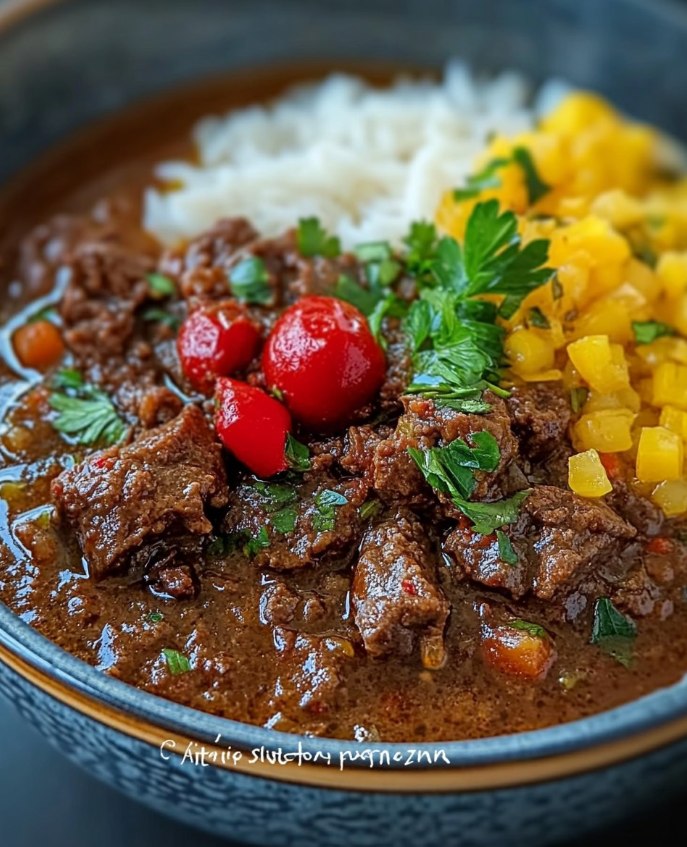There’s something magical about a dish that warms both the kitchen and the soul. One day, while experimenting with spices in my pantry, I stumbled upon sumac—a tangy, vibrant powder often used in Middle Eastern cooking. It sparked an idea: why not try it in a hearty beef stew? That’s how I discovered Iranian Sumac Beef, a dish so rich in flavor that it quickly became a family favorite. If you’re looking for a recipe that feels like a warm hug on a cold day, this one’s for you.
A Little Taste of Persia
This Iranian Sumac Beef ragoût is a celebration of Persian flavors, where tender chunks of beef are slow-cooked with fragrant spices and brightened by the zesty touch of sumac. Sumac, with its lemony tang, has been a staple in Persian cuisine for centuries. Traditionally, it’s sprinkled over salads or used as a seasoning for grilled meats. But when added to a stew, it transforms the dish into something truly special. The combination of spices like turmeric, cinnamon, and paprika creates layers of warmth, while the sumac adds a refreshing acidity that balances the richness of the beef.
Why You’ll Love This Recipe
What makes this Iranian Sumac Beef so irresistible? First, it’s packed with bold, comforting flavors that feel exotic yet familiar. Second, it’s surprisingly simple to make—just brown, simmer, and serve. Plus, it’s versatile enough to pair with rice, bread, or even couscous. Whether you’re a seasoned cook or just starting out, this recipe is forgiving and rewarding. Trust me, your taste buds will thank you!
Perfect Occasions for This Dish
This Iranian Sumac Beef is perfect for any cozy gathering. Imagine serving it on a chilly Sunday afternoon or at a casual dinner party with friends. It’s also a great option for meal prep since the flavors deepen over time. And let’s not forget holidays—this dish would shine at Thanksgiving or Christmas as an alternative to traditional roasts.
Ingredients
- 600 g of beef (shoulder or shank), cut into bite-sized pieces
- 2 tablespoons olive oil
- 1 large onion, finely chopped
- 3 garlic cloves, thinly sliced
- 1 tablespoon sumac
- 1 teaspoon ground turmeric
- ½ teaspoon ground cinnamon
- 1 teaspoon sweet paprika
- 3 cups (750 ml) beef broth
- 2 potatoes, peeled and cubed
- 2 tomatoes, grated or ½ cup canned crushed tomatoes
- 1 tablespoon tomato paste
- Salt and pepper to taste
- 1 handful fresh parsley, chopped, for garnish
Substitution Options
If you can’t find sumac, no worries! A splash of lemon juice works well as a substitute. For vegetarians, swap the beef with mushrooms or chickpeas. If you don’t have fresh tomatoes, canned diced tomatoes are a great alternative. And if you’re out of beef broth, vegetable broth will do the trick without compromising the flavor.
Step 1: Preparing the Meat
Heat the olive oil in a large pot over medium-high heat. Add the beef pieces and let them sizzle until golden brown on all sides. This step seals in the juices and gives the meat a beautiful caramelized crust. Once browned, remove the beef from the pot and set aside. Pro tip: Don’t overcrowd the pot—brown the meat in batches if needed to avoid steaming instead of searing.
Step 2: Sautéing the Aromatics
In the same pot, add the chopped onions and sauté until they turn translucent, about 5 minutes. Then toss in the garlic, turmeric, cinnamon, paprika, and sumac. Stir everything together and cook for another minute or two. As the spices hit the hot oil, your kitchen will fill with their intoxicating aroma. This is the moment you know something delicious is happening!
Step 3: Building the Stew
Return the beef to the pot and stir in the grated tomatoes and tomato paste. Pour in the beef broth until the meat is just covered. Bring the mixture to a boil, then lower the heat, cover, and let it simmer gently for an hour. During this time, the beef becomes incredibly tender, absorbing all those wonderful flavors. Pro tip: Resist the urge to lift the lid too often—it slows down the cooking process.
Step 4: Adding the Potatoes
After an hour, throw in the cubed potatoes. Let the stew continue to simmer for another 30-40 minutes, or until the potatoes are fork-tender. Watching the potatoes soak up the savory broth is almost hypnotic. By now, the stew should be thick and fragrant, ready to welcome its final seasoning adjustments.
Step 5: Final Touches
Taste the stew and adjust the seasoning with salt, pepper, or a bit more sumac if you crave extra tanginess. Sprinkle freshly chopped parsley on top before serving. Chef’s tip: For an elevated presentation, drizzle a little olive oil over each bowl before garnishing with parsley. It adds a glossy finish that looks restaurant-worthy.
Timing
Prep Time: 15 minutes
Cooking Time: 2 hours
Total Time: 2 hours 15 minutes
Chef’s Secret
For an unexpected twist, add a pinch of dried mint to the stew during the last 10 minutes of cooking. It adds a subtle freshness that complements the sumac beautifully.
Extra Info
Did you know that sumac comes from the berries of the sumac shrub? These berries are dried and ground into a powder, giving it that distinctive citrusy flavor. In ancient times, sumac was prized not only for its taste but also for its medicinal properties. Pretty cool, right?
Necessary Equipment
- Large pot or Dutch oven
- Wooden spoon
- Knife and cutting board
- Measuring spoons
Storage Tips
Store leftovers in an airtight container in the fridge for up to 3 days. The flavors meld beautifully overnight, making it taste even better the next day. To reheat, simply warm it on the stovetop over low heat, adding a splash of water or broth if the stew seems too thick.
For longer storage, freeze portions in freezer-safe bags or containers. Label them with the date, and they’ll keep for up to 3 months. When reheating from frozen, thaw overnight in the fridge and then warm gently on the stove.
If you’re planning to serve this dish later in the week, consider making it ahead of time. Not only does it save effort, but the flavors intensify, ensuring a memorable meal every time.
Tips and Advice
- Use high-quality spices for the best results—they make a world of difference.
- Pat the beef dry with paper towels before browning to ensure a good sear.
- Don’t rush the simmering process; slow cooking ensures tender meat and deep flavors.
Presentation Ideas
- Garnish with a sprinkle of sumac for a pop of color.
- Serve in shallow bowls with a dollop of yogurt on the side.
- Place a sprig of fresh parsley on top for a rustic touch.
Healthier Alternatives
Here are six variations to lighten up this Iranian Sumac Beef:
- Lean Beef Option: Use lean cuts like sirloin to reduce fat content.
- Vegetarian Version: Replace beef with lentils or chickpeas for a plant-based twist.
- Low-Sodium Broth: Opt for reduced-sodium broth to control salt intake.
- More Veggies: Add carrots, zucchini, or spinach for extra nutrients.
- Gluten-Free: Ensure all ingredients, especially the broth, are gluten-free.
- Less Oil: Use a non-stick pan to minimize the amount of oil needed.
Common Mistakes to Avoid
Mistake 1: Skipping the Browning Step
Browning the beef might seem optional, but it’s crucial for building depth of flavor. Without this step, the stew lacks that rich, caramelized base. Pro tip: Take your time and let the meat develop a nice crust before removing it from the pot.
Mistake 2: Overcooking the Potatoes
Potatoes can easily turn mushy if left in the stew too long. Add them towards the end of cooking to keep them firm and intact. Pro tip: Cut the potatoes into uniform sizes for even cooking.
Mistake 3: Using Old Spices
Spices lose their potency over time, which can result in a bland stew. Always check the expiration dates and store spices in a cool, dark place to preserve their freshness.
FAQs
What is sumac?
Sumac is a spice made from dried and ground sumac berries. It has a tangy, citrusy flavor and is commonly used in Middle Eastern and Mediterranean cuisines. Its bright red hue and unique taste make it a standout ingredient in dishes like this Iranian Sumac Beef.
Can I use chicken instead of beef?
Absolutely! Chicken thighs work wonderfully in this recipe. Just adjust the cooking time to prevent overcooking, as chicken cooks faster than beef.
Where can I buy sumac?
You can find sumac at specialty grocery stores, Middle Eastern markets, or online retailers. It’s becoming increasingly popular, so many supermarkets now carry it in their spice aisles.
Is this dish spicy?
No, this dish isn’t spicy. The heat level is mild, thanks to the use of sweet paprika and other warming spices. However, you can always add chili flakes if you prefer a kick.
Can I make this dish vegetarian?
Yes! Substitute the beef with hearty vegetables like mushrooms, eggplant, or chickpeas. The result will still be flavorful and satisfying.
How do I store leftovers?
Store leftovers in an airtight container in the fridge for up to 3 days. Reheat gently on the stovetop, adding a splash of broth if needed.
What sides go well with this stew?
Rice, flatbread, or a simple green salad pair beautifully with this Iranian Sumac Beef. The starches help soak up the flavorful broth, while greens provide a refreshing contrast.
Can I freeze this dish?
Yes, this stew freezes well. Portion it into freezer-safe containers and label with the date. It will keep for up to 3 months.
Do I need to peel the tomatoes?
No, peeling isn’t necessary. Simply grating the tomatoes releases their juices and blends seamlessly into the stew.
Why does my stew taste bland?
If your stew tastes bland, check the seasoning. Add more salt, pepper, or sumac to enhance the flavors. Also, ensure you’re using fresh spices for maximum impact.
Final Thoughts
This Iranian Sumac Beef is more than just a recipe—it’s an invitation to explore new flavors and create memories around the table. With its balance of warmth and tanginess, it’s sure to become a cherished addition to your repertoire. So grab your apron, gather your ingredients, and get ready to wow everyone with this delightful Persian-inspired stew. Happy cooking!

Iranian Sumac Beef
Ingredients
Equipment
Method
- Heat olive oil in a large pot over medium-high heat and brown the beef pieces on all sides; remove and set aside.
- In the same pot, sauté chopped onions until translucent, about 5 minutes, then add garlic, turmeric, cinnamon, paprika, and sumac; stir for 1-2 minutes.
- Return beef to the pot, stir in grated tomatoes and tomato paste, add beef broth, bring to a boil, then lower heat, cover, and simmer for 1 hour.
- Add cubed potatoes and simmer for another 30-40 minutes until potatoes are fork tender.
- Taste the stew and adjust seasoning, then sprinkle with freshly chopped parsley before serving.
